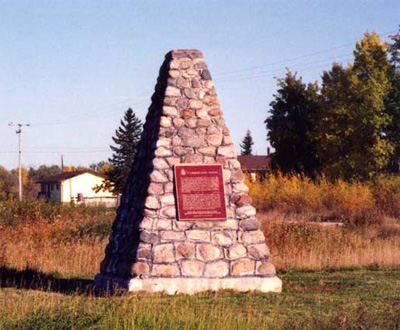Cumberland House National Historic Site of Canada
Cumberland House, Saskatchewan

Cairn and plaque
(© Parks Canada Agency / Agence Parcs Canada, n.d.)
Address :
Road 123, Cumberland House, Saskatchewan
Recognition Statute:
Historic Sites and Monuments Act (R.S.C., 1985, c. H-4)
Designation Date:
1924-06-04
Dates:
-
1821 to 1821
(Significant)
-
1965 to 1965
(Significant)
-
1774 to 1774
(Established)
Event, Person, Organization:
-
Samuel Hearne
(Person)
-
Matthew Cocking
(Person)
-
William Tomison
(Person)
-
Hudson Bay Company
(Organization)
-
North West Company
(Organization)
Other Name(s):
-
Cumberland House
(Designation Name)
-
Fort Cumberland
(Other Name)
Research Report Number:
1968-029, 2011-CED/SDC-003
DFRP Number:
56579 00
Plaque(s)
Existing plaque: Road 123, Cumberland House, Saskatchewan
For a century after its founding in 1670 the Hudson's Bay Company was content to draw Indians down to the Bay to trade; but in 1774, after Canadian "pedlars" on the Saskatchewan had begun to intercept this trade, Samuel Hearne was sent from York Factory to establish Cumberland House, the first of the Company's great inland posts. Under Hearne, Matthew Cocking and William Tomison, this became the nerve centre for competition with the north West Company until the union of the two companies in 1821. Thereafter it remained an important trading establishment for many years.
*Note: This designation has been identified for review. A review can be triggered for one of the following reasons - outdated language or terminology, absence of a significant layer of history, factual errors, controversial beliefs and behaviour, or significant new knowledge.
Description of Historic Place
Cumberland House National Historic Site of Canada is located on Pine Island in the Saskatchewan River in the district of Cumberland Lake, Saskatchewan. Cumberland House was the Hudson’s Bay Company first inland fur-trading post, around which Saskatchewan’s oldest permanent settlement was founded in 1774 by Samuel Hearne, explorer and fur-trader. This community’s only visible remnant today is a thick, stone-walled 1890s powder house, once used for storing gunpowder. Also preserved at the site are parts of the Northcote, a fur trade steamboat used at Batoche during the North-West Resistance. Adjacent to Cumberland House is the Cumberland House Cree Nation Reserve, part of the original Cumberland House settlement. Official recognition refers to the single, polygonal parcel of land that encompasses the boundary of the Hudson’s Bay Company Property at the time of designation.
Heritage Value
Cumberland House was designated a national historic site of Canada in 1924 because:
its establishment, by Samuel Hearne in 1774, marked a new era in the fur trade and was the first of the Hudson Bay Company’s great inland posts; and, it served as the nerve center for competition with the North West Company until the two companies joined in 1821, remaining an important trading establishment for many years.
Cumberland House is the Hudson’s Bay Company’s first inland fur-trading post, and also Saskatchewan’s oldest permanent settlement. By the late 1700s rival Montréal traders were intercepting trappers on their way to trade with the Hudson’s Bay Company posts on Hudson’s Bay. To counter this Samuel Hearne set out from York Factory and founded Cumberland House in 1774. This, the company’s first great inland trading post, marks a change in policy. Protected by a palisade the site was strategically located near major canoe routes and potential First Nations trading partners. From this time the Hudson’s Bay Company no longer traded primarily at its forts on Hudson Bay. In 1793, the original post relocated two kilometres west to a site, on and adjacent to present-day Provincial Park property, where it continued operating until 1965.
As the Hudson’s Bay Company extended its posts inland, Cumberland House became an important administrative, distribution and trading centre. Its role, however, declined after the Hudson’s Bay Company’s 1821 union with the North West Company, and as more direct trade routes to the interior developed. Norway House on Lake Winnipeg eventually became the inland headquarters. Today the powder house, a rare example of a 19th century HBC gunpowder storage facility, is the only remaining original structure at Cumberland House. From 1874 the Hudson’s Bay Company’s first steam-powered sternwheeler, the Northcote, began plying the Saskatchewan River. Cumberland House became an important centre for steamboat freight and passengers. During the 1885 Resistance the Northcote transported troops and supplies for the assault on Batoche and afterwards evacuated causalities to Saskatoon. In 1886 the Northcote was beached and by 1900 the Hudson Bay Company’s steamships ceased operations. In 1925 Cumberland House’s 150 year role as transportation hub and distribution centre ended when the railway reached Flin Flon.
Character-Defining Elements
The key elements that contribute to the heritage character of this site include: - its location on Pine Island in the Saskatchewan River within the corporate limits of the Northern Village of Cumberland House; - the setting on a flat grassed area within a treed park overlooking the Saskatchewan River; - the integrity of any surviving or as yet unidentified archaeological remains which may be found within the site, including features, artefacts and in situ vestiges belonging to the period of operation of Cumberland House from 1774 onwards, in their original placement and extent; - the powder house, its original design and materials, square plan, pyramidal roof, and design features, including its two-foot-thick stone walls, heavy plank doors, square building plan and pyramidal roof, and its anti-spark copper nails, and interior lead cladding on wood surfaces and two-inch thick by eight-inch wide plank floor to keep explosives dry, and also its location away other buildings; - the fittings from the Northcote that speak to the site’s connection with steamship transportation, including the boilers, and the signaling cannon; - the visual and landscape character within the park, and the viewscapes from the site towards the river.